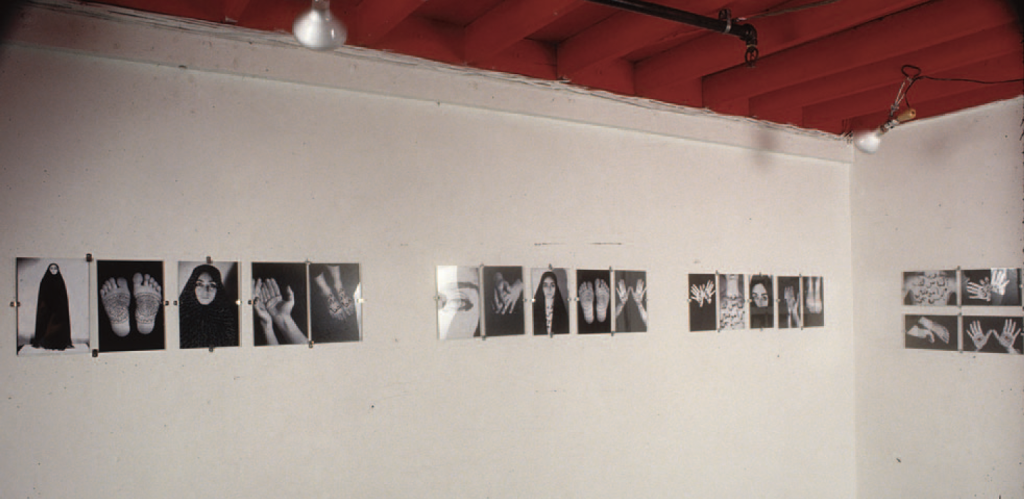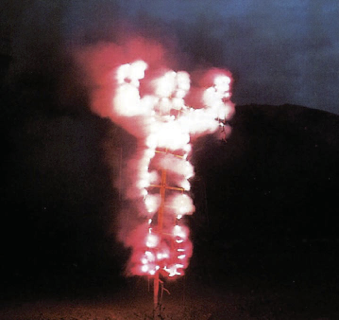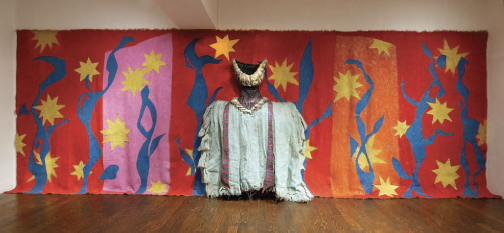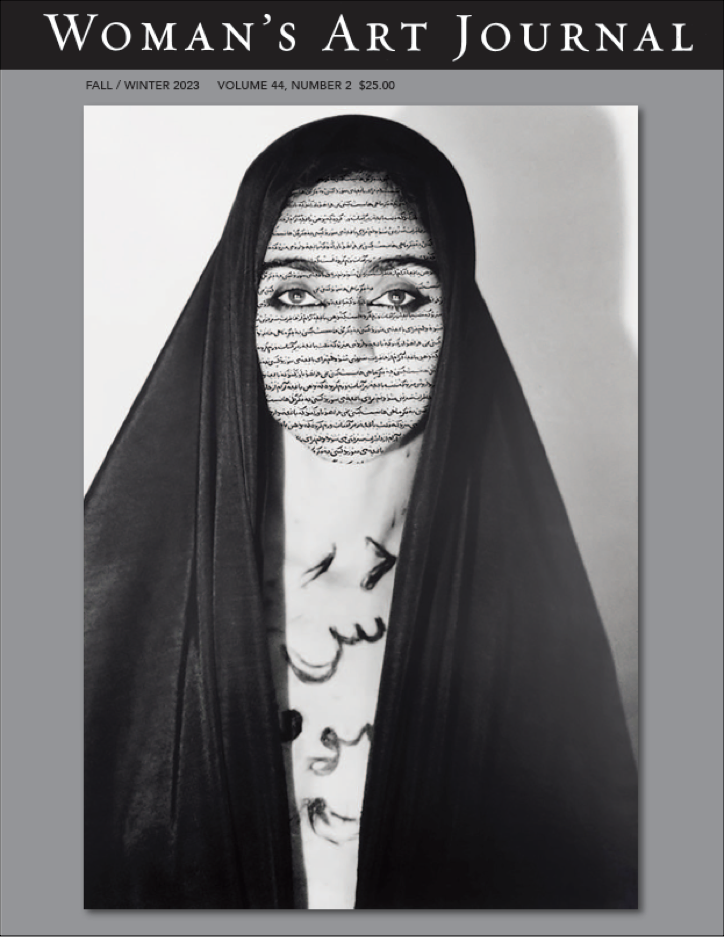Institutional subscribers can access this issue by clicking here. The issue is available for purchase in print and digital (PDF) format. To subscribe to WAJ, click here.
The editors of Woman’s Art Journal are profoundly grateful for our growing international readership, reflected through the daily stream of proposals for articles and book reviews, and requests for partnerships, received via our successful new website. WAJ Fall/Winter 2023 recognizes these global relationships, focusing on artists from varied origins, including women born in Iran, Cuba, Japan, and the US, all of whom, for our articles, developed transdisciplinary artistic modes in the late 1970s and ‘80s incorporating elements of photography and performance.
Our stunning cover and lead article by Erin Devine considers transnational artist Shirin Neshat, who came to the US from Iran in 1973, at the age of sixteen. Soon she was studying painting at the University of California, Berkeley. When she arrived in New York City her work was recognized for haunting self-portraits, and later, for her memorable videos. Devine contextualizes Neshat’s formative US period in her first major installation, Unveiling, at Franklin Furnace in April 1993, the genesis of her renowned photography series on Iranian women, and early sculptural objects and Super-8 projections. Unveiling’s transgressive presentation as “performative excavations” and “portrait-subjects” strategically destabilized identities and deployed the artist’s gaze. Devine argues how Neshat’s codified body, dressed in chador with bodily close-ups ornamented in Persian calligraphy, may be entwined within a broader complex of cultural traditions and political forces that “contradictorily celebrate and violently repress women.”

Ana Mendieta was exiled from her native Cuba at age eleven, when her father was sent to jail. She was transported to an orphanage in Iowa, and later became a performance artist as well as a sculptor. Philip Kelleher’s “close looking” examines the bodily presences of the Silueta series, initiated in 1973 and pursued over one hundred photographic and performative iterations. Kelleher’s astute material analysis and psycho-analytic lens draw on the notion of “curdling,” broadly defined here as the impurity of the silhouette, to investigate the artist’s mixed European and Indigenous American heritage, and the undermining of the photographic medium’s claims to rational language and logic. As a Cuban artist denied her family and country, Mendieta created the Silueta as a sign of anchoring the body, a process that also established her identity paradoxically within and beyond the borders of feminism and singular cultural categories of woman, artist, and nature.

Artists Barbara Ciurej and Lindsay Lochman are collaborators who planned to “upend artistic and gendered taboos in photography.” Beginning their partnership after meeting at the Institute of Design in Chicago, they agreed that feminist politics would be at the core of their practice. Joanna Gardner-Huggett explains that Ciurej and Lochman organized their photographic series as an attempt to disrupt gendered expectations in the domestic realm. At ID, they became aware of earlier women photographers who explored the nude female body, including Barbara Morgan, Imogen Cunningham, Judy Dater, and others. Collaborative works by these two young women led to many provocative narratives utilizing their own nude bodies—breasts and nude torsos find their way to dinner tables, outdoor settings, and scrabble games played by men.
Still Wet from the Cocoon and Glory on a Budget are featured series and acknowledge various feminist forebears. Ciurej and Lochman use their own bodies through humor, parody, and feminism to consider how the domestic realm intersects with the public sphere.
The Japanese artist Maemoto Shōko was praised in the 1980s as one of the “Chō-shōjo” (Super Girls) while participating in many significant exhibitions in Japan and abroad. Scholar Kokatsu Reiko examines the unique and complicated categorization of Maemoto’s career in 1980s Japan prior to the resurgence of her exhibitions in 2020, analyzing the artist’s critical development, the feminist trends and histories in Japan, and the representation of Japanese women artists on the global biennial circuit. Maemoto developed complexly layered “felt craft” techniques and embroideries with denim and dongolos cloth, accessories, cute objects, and Naruko. Early works from the mid-1980s suggest her fears of childbirth. Later installations address the struggle to find her place as a woman artist in Japan and the prevalence of social themes with difficult subject matter.

The superlative reviews compiled by WAJ editor Alison Poe offer close engagements with new publications on drag, race, sexuality, mothering, photography, costume, among other interdisciplinary feminist art-historical studies. Examining the historical binaries and “slippage” of the categorical terms “abstraction” and “representation,” Sarah Cowan’s extensive double review, on queerness in contemporary abstraction and Black contemporary artist Jennifer Packer, strives for a three-dimensional humanist reading embedded in the artistic agency of non-normative spaces, embodiment, and oblique meanings. Megan Driscoll’s review frames the fraught perspectives of Black matrilineage, revolution, and slavery, narrative extensions of “the double-consciousness of Black life” leveraged through photography. Nika Elder elucidates Barbara Chase-Riboud’s reputation and creativity as a visual artist beyond her lauded achievements in poetry and literature. The polyvocal voices of motherhood, radical self-care, and art production are addressed by Li Yang’s review of the art collective MATERNAL FANTASIES, and the polyphonic fiber art and indigenous “borderlines” of Consuelo Jimenez Underwood are unraveled by Matthew Simms.
The catalogue of Chinese-American artist Hung Liu at the National Portrait Gallery is reviewed thoughtfully by scholars Meng Yi and Jane Chin Davidson. Sarah Humphreville expands the narratives and geographical hegemony of women and global abstraction, and Lauren Cesiro exposes how the New Woman shaped photography as vehicles for self-expression and self-determination. The exhaustively researched biography on Florine Stettheimer is presented by Heather Hole. Neoclassical fashions (specifically white muslin dresses) of the 1790s catalyze Theresa Kutasz Christensen’s review. Adelina Modesti analyzes Mary Garrard’s latest book on Artemisia Gentileschi in the context of women’s political agency and feminism. Catherine Puglisi turns her attention to a significant new exhibition catalogue on early modernist painter Lavinia Fontana.
Joan Marter and Aliza Rachel Edelman
Editors, Woman’s Art Journal
Institutional subscribers can access this issue by clicking here. The issue is available for purchase in print and digital (PDF) format. To subscribe to WAJ, click here.

p. 2
Parallel Perspectives
By Joan Marter And Aliza Edelman
p. 3-42
Portraits, Issues and Insights
p. 3
Beyond Representation: The Evolution of Embodied Experience in Shirin Neshat’s Early Art
By Erin Devine
p. 13
Curdling the Photographic Image: Ana Mendieta’s Silueta
By Philip Kelleher
p. 22
Barbara Ciurej and Lindsay Lochman: Feminist Collaboration and Domestic Disruption
By Joanna Gardner-Huggett
p. 33
From The Empty Dress to the Advent of the Goddess: Maemoto Shōko, 1980s to the Present
By Kokatsu Reiko
p. 43-73
Reviews
p. 43
Dragging Away: Queer Abstraction in Contemporary Art By Lex Morgan Lancaster; Jennifer Packer: The Eye is Not Satisfied with Seeing Edited by Melissa Blanchflower and Natalia Grabowska
Reviewed by Sarah Louise Cowan
p. 46
Black Matrilineage, Photography, and Representation: Another Way of Knowing Edited by Lesly Deschler Canossi and Zoraida Lopez-Diago
Reviewed by Megan Driscoll
p. 49
Re-Assembling Motherhood(s): On Radical Care and Collective Art as Feminist Practices By Maternal Fantasies; edited by Sascia Bailer, Magdalena Kallenberger, and Maicyra Leão Teles e Silva
Reviewed by Yang Li
p. 52
Barbara Chase-Riboud Monumentale: The Bronzes Edited by Stephanie Weissberg; I Always Knew: A Memoir by Barbara Chase-Riboud
Reviewed by Nika Elder
p. 54
Consuelo Jimenez Underwood: Art, Weaving, Vision Edited by Laura E. Pérez and Ann Marie Leimer
Reviewed by Matthew Simms
p. 57
Hung Liu: Portraits of Promised Lands Edited by Dorothy Moss
Reviewed by Meng Yi and Jane Chin Davidson
p. 59
Women in Abstraction Edited by Christine Macel and Karolina Ziebinska-Lewandowska
Reviewed by Sarah Humphreville
p. 61
The New Woman Behind the Camera By Andrea Nelson, with contributions by Mia Fineman, Elizabeth Cronin, Mila Ganeva, Kristen Gresh, Elizabeth Otto, Kim Sichel, and others
Reviewed by Lauren Cesiro
p. 64
Florine Stettheimer: A Biography By Barbara Bloemink
Reviewed by Heather Hole
p. 66
The Age of Undress: Art, Fashion, and the Classical Ideal in the 1790s By Amelia Rauser
Reviewed by Theresa Kutasz Christensen
p. 68
Artemisia Gentileschi and Feminism in Early Modern Europe By Mary D. Garrard
Reviewed by Adelina Modesti
p. 71
Lavinia Fontana: Trailblazer, Rule Breaker By Aoife Brady, with contributions by Babette Bohn and Jonquil O’Reilly
Reviewed by Catherine R. Puglisi
Color Plates